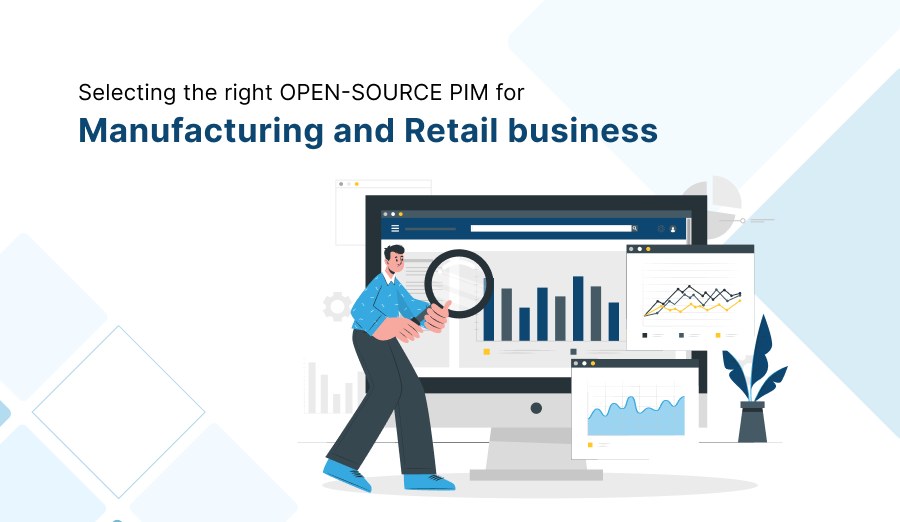Streamline Your Data Processes - Start a project!
Get customized solutions for your business - Try Our Services Today!
Streamline Your eCommerce Operations - Try Our Services Today!

Selecting the right OPEN-SOURCE PIM for Manufacturing and Retail
In today's omnichannel world, providing accurate and consistent product information is crucial for a seamless customer experience. Enter Product Information Management (PIM), the superhero tasked with wrangling product data from chaotic silos into a beautiful and centralized manner.
There are many PIMs available in the market and the two major types are proprietary software (closed-source) and open-source PIM. But hold on, not all PIM solutions are made equal. For manufacturers and retailers alike, open-source PIMs offer a cost-effective, adaptable option, but choosing the right one can feel like searching for a diamond in a data haystack.
The dilemma is often the choice between open-source PIM and proprietary software PIM for your organization. Within the proprietary software PIM space, there are prominent solutions like SAP, Informatica, Oracle, and IBM InfoSphere compete, while open-source alternatives such as PIMCore, Akeneo, Inriver, Stibo, Contentserv, and Salsify thrive in the market.
This blog explores how choosing the open-source PIM solution can be a real game changer for businesses in today’s dynamic digital business landscape.
Why Do Manufacturing and Retail Businesses need a PIM System:
Let’s look at some significant use cases of PIM in Manufacturing and Retail companies, and how a PIM facilitates manufacturers and retailers.
For Manufacturing companies
Centralized Product Data: Manufacturing companies deal with a vast amount of product data, including specifications, SKUs, parts, and manufacturing details. The PIM system serves as a central source of truth, implementing a PIM system helps to centralize this data and ensure consistency across various channels and departments.
Standardized Data for Efficiency: PIM enables the standardized format of data, which makes it easier for manufacturers to communicate with suppliers, distributors and retailers. Making data standardized ensures that everyone is involved in the supply chain work with accurate and consistent product information. Which ultimately leads to better efficiency of the team.
Product Variation Management: A medium or large size of manufacturer offers multiple variations of products (e.g. sizes, colours, features), which requires an efficient PIM system in place. A PIM system helps manage and present these variations accurately, reducing errors in production and distribution.
Streamlined New Product Introductions (NPI): Moreover, PIM facilitates the smooth introduction of new products by managing data from the design and development stages, which ensures seamless integration with existing systems.
For Retail Companies:
Product Data Aggregation: Retailers often deal with a variety of products from different suppliers. To help them create a comprehensive product catalogue, Product Information Management (PIM) systems aggregate product information from various sources.
Consistent Omnichannel Experience: In this competitive digital landscape, it is crucial to maintain consistency across online and offline channels. PIM ensures that product information such as prices, descriptions, and specifications are uniform across websites, mobile apps, in-store displays, and other channels.
Dynamic Pricing and Promotions: PIM systems integrate with pricing tools, allowing retailers to manage and update prices, discounts, and promotions across multiple platforms simultaneously. This feature enables dynamic pricing and promotions, which can enhance customer experience and increase sales.
Enhanced Customer Experience: Accurate and detailed product information, including images, descriptions, and specifications, provided by PIM systems, improves customer trust and satisfaction, reducing returns and increasing conversions.
Efficient Inventory Management: PIM also helps retailers track inventory levels, locations, and product availability in real time. By doing so, retailers can efficiently manage their inventory, avoid stockouts, and reduce overstock situations.
In both manufacturing and retail, PIM systems serve as a backbone for managing product-related information, ensuring accuracy, consistency, and efficiency throughout the product lifecycle, from creation to distribution and sales.
How Open-Source PIMs Rock for Manufacturing and Retail:
Cost-efficiency: Open-source PIM enables you to embrace the power of managing product data cost-effectively. So, Ditch the hefty subscription fees and embrace the freedom of open-source licensing. Open-source products typically feature very low licence fees or no licence fee. Which allows more control over your data, and less strain on your wallet.
Customization: Bend it, mould it, customize it! Open-source PIMs allow you to tailor the system to your specific needs, ensuring your workflows purr like a well-oiled machine. Open-source software provides full accessibility to its source code, which enables its users to make individual adaptations with high customisation options.
Agility: Need to pivot faster than a ballerina on ice? Open-source lets you react to market changes with lightning speed, tweaking features and extensions to keep your data dance moves sharp.
Community Power: Stuck in a data swamp? Don't fret! Open-source PIMs come with vibrant communities of developers and users ready to lend a helping hand (and a line of code) when you need it most.
But wait, there’s a Catch (Don't Worry, It's a Small One):
Technical Expertise: Open-source requires some technical know-how for installation, configuration, and maintenance. If you're not fluent in code, consider partnering with a PIM implementation expert.
Limited Support: While communities are fantastic, dedicated support channels might be less readily available compared to commercial PIMs. You need to be prepared to dive headfirst into documentation and forums if you need hand-holding.
Decreasing popularity of proprietary software in the world
Many businesses are increasingly turning to open-source software solutions to meet their challenges and build their infrastructure strategies.

According to the State of Enterprise Open-Source report from Red Hat® Report, IT leaders are prioritizing enterprise open source over traditional solutions. They are also more likely to choose a vendor who contributes to the open-source community, with 82% reporting this as a key factor in their decision-making process.
So, how do you navigate the open-source PIM jungle and find the perfect fit? Here's your survival guide:
1. Know Your Needs: Before you even sniff an open-source PIM, understand your pain points. What product data challenges are plaguing your manufacturing or retail processes? Do you need robust variant management? Multi-lingual capabilities? Omnichannel integrations? Make a list, prioritize, and let it guide your search.
2. Research & Compare: Dive into the open-source PIM ocean! Popular options like Pimcore, Akeneo, and Inriver offer impressive functionalities, each with its unique strengths and weaknesses. Read reviews, check demos, and don't be afraid to get your hands dirty with trial versions.
3. Community Check: Remember that thriving community we mentioned? Engage with it! Ask questions, participate in forums, and gauge the responsiveness and helpfulness of other users. A vibrant community is a strong indicator of a healthy open-source project.
4. Features vs. Customization: Be honest with yourself. Do you need a feature-rich PIM out of the box, or are you comfortable tinkering with code to achieve your ideal data nirvana? Remember, the more customization you require, the more technical expertise you'll need.
5. Don't Go Solo: Even with an open-source PIM, you don't have to be a lone warrior. You can partner up with experienced PIM consultants or implementation specialists. They can help you navigate the setup process, answer your burning questions, and ensure your data migration is a smooth ride.
Choosing the right open-source pim: Pimcore
Among the open-source PIM solutions available, Pimcore stands out as a preferred choice. Its superior Integration capabilities, Flexibility, Community Support, Scalability and alignment with industry standards make it the optimal PIM solution for IT Leadership in manufacturing and retail sectors.
As per the latest report of Ventana Research, Pimcore is rated innovative in Product Experience Management. Also, Pimcore has received a lot of recognition and reviews from trusted customers in Gartner Peer Insights and was named a “Customers’ Choice 2022 and 2023.
Final Thought
Remember, choosing the right open-source PIM is about finding the perfect balance between functionality, customization, and technical capabilities. With careful planning and research, you can transform your chaotic product data into a symphony of efficiency and customer satisfaction. So, go forth, explore the open-source PIM world, and find your data's dream home!
Categories
- Digital Asset Management (DAM)
- Artificial Intelligence (AI)
- Product Information Management (PIM)
- E-commerce
- Master Data Management (MDM)
- Digital Experience Management
- Customer Data Platform
- Data Management Platform
- Recruitment
- Covid-19
- Digital Workspace
- Digital Experience Portal (DXP)
- Omnichannel Experience
- Pimcore
- Framework Comparison
- Software Development
- Learning Management Solution (LMS)
- CRM System
- Sales Portal
- Salesforce
- Blockchain Development
- App Development
- Technology
Similar Blogs

3 Step Guide to Implementing a PIM System
Looking to start an ecommerce store? Trying to redesign the one that you've already established? Fro...
Read More
Top 9 Product Information Management (PIM) Challenges: How to Overcome Them
Consumerism is at its peak today. Be it any industry, any category, or any geographical location, th...
Read More
Pimcore PIM for Multichannel Marketing: How it Helps You Reach Your Audience
The rising eCommerce sales in the current market have set new standards for businesses. The massive ...
Read More
Enhancing Efficiency and Accuracy: How AI and ML are Transforming PIM Systems
In the ever-evolving digital landscape, companies face the challenge of effectively managing vast am...
Read More

